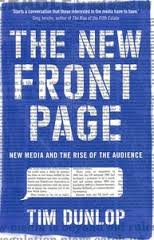Dunlop, Tim - The New Front Page: New Media and The Rise of the Audience, Scribe Publications, Brunswick, Victoria, Australia, pp. 272, ISBN 978-1-922070-54-8
Reviewed by Barbara Alysen - University of Western Sydney
Never mind the title, which suggests another homage to the blows developing and digital media have dealt to the dinosaurs of old-style news, this book takes you on a journey and it ends in a surprising place.
It begins with the now familiar narrative of the ways in which bloggers and social media exposed the fault lines in the mainstream media’s relationship (or lack of it) with their audiences. The first example used here is Canberra political reporter Margo Kingston’s Webdiary, launched by Fairfax online in mid 2000. This was not an obvious game changer and Dunlop charts the misgivings it raised on all sides. Hindsight has revealed its groundbreaking status.
The second example is the author’s own The Road to Surfdom, launched two years after Webdiary. At this point Dunlop was living in the U.S., which gave him the opportunity to chart the differences, especially in reception and effect, between Australian and American political blogs. After four years of writing independently, Dunlop was invited to blog under the News Ltd. umbrella where he would experience for himself the differing cultures of the blogosphere and the mainstream media.
In one sense, what Tim Dunlop has written is a memoir. It traces his own path through new media to the mainstream and on to the patchwork career (academic, blogger, member of television discussion panels and so on), common to many in the media these days. In the process, he analyses the nature of blogging, its impact, and interactions with readers (including journalists), through the lens of his own experiences. What bloggers have done well, he observes, is interact and respond to the public pulse. Journalists can be a bit too cliquish and too limited by their sources. If journalists have seen bloggers as competition, Dunlop argues they have missed the point:
Bloggers weren’t adding to the conversation; they were creating a conversation where none had previously existed. While journalists were cultivating backroom sources and other anonymous leads, we were cultivating an audience.
Blogging was not a species of journalism; it was a species of citizenship. (72)
There are many other insights here, ranging from the challenges of servicing an audience in the new media environment (responding to feedback is demanding and not everyone is civil), to the failure of audience research to lift the bar in journalism.
Dunlop is hardly the first new media writer to point out that traditional journalism lost opportunities and lost its way when confronted by the digital revolution. But this is not a book that sees the mainstream media as a lost cause – and it is his championing of old media, despite their failings, that makes book especially valuable. Indeed, Dunlop argues that ‘democracies need mainstream media more than they need citizen journalists’ (227). But democracies also need their heritage media to be more in touch and more accountable. And they need audiences prepared to pay for the costly, demanding and time-consuming work that only professional journalism, generated by large and powerful newsrooms, can produce.
About the reviewer
Barbara Alysen is Senior Lecturer in Journalism in the School of Humanities and Communication Arts at the University of Western Sydney (UWS). She is the author of several books including The Electronic Reporter: Broadcast Journalism in Australia (2012) and Reporting in a Multimedia World (2011)

